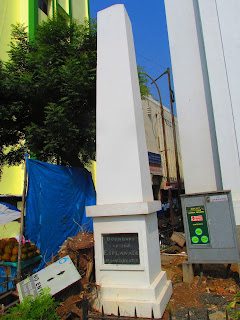The Esplanade Boundary Pillar
On the busy NSC Bose Road of Parrys corner in Chennai stands a historically significant obelisk, around 250 years old.
The French invaded Madras, which was under the control of the British, on 7th September 1746. It was an easy victory for the French. Dupleix, who led the French army, imprisoned a lot of British officers as well as civilians. He was determined to destroy Fort St. George. However, he was not very lucky to remain in the city. The Treaty of Aix-la-Chapelle ended the war by providing for Madras to be returned to the British. Hence, the French left Madras in 1749 CE.
Before leaving Madras, the French had started razing down the structures to 400 yards from the northern wall of the Fort for security reasons. The weavers and dyers brought from Nellore and Machilipatnam were staying there, and it was called the "Black Town". It was the first Indian settlement developed by the Britishers in Madras.
There was another French invasion that happened in 1758-59. After taking over the control of the city, the British resumed the task that was started by the French. The Black Town was entirely demolished by 1760. The locality was considered a security hazard, so its residents were moved to the nearby villages of Muthialpet and Peddanaickenpet. Thus, a new Black Town was formed.
In 1772 CE, the southern boundary of the New Black Town was fixed with six obelisk stones. Construction beyond this boundary was not allowed by the British. Out of those six pillars, only one dating 1st January 1773 CE still survives, in front of the Dare House Building. The space beyond this 15 feet high pillar was developed as an Esplanade. It remained an Esplanade until the High Court building was constructed in the 1880s.
Happy travelling.

.JPG)


Comments
Post a Comment